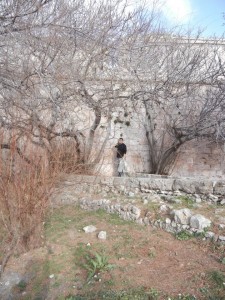There is certainly something to be said for standing before the great monuments of the Western world and gazing in awe at the megalithic symbols of civilization as we know it. Whether it be walking beneath the ancient stone walls of Rome’s Coliseum, traversing the marvelously Gothic transept of Paris’ Notre Dame or exploring the ruins of a prison on the small, mountainous islands of Frioul off the coast of Marseille, these acts strike the heart of anyone even remotely interested in history. We study all of these sorts of things in our classes, our textbooks and on our TV sets, but when the time comes to reach out and grasp that which has been merely words on a page or a picture in a book, the objects of our studies become so much more.
It is often said that the history major is one of the most “humanizing” disciplines in the Liberal Arts curricula. I, for one, took this to mean that we, as historically-minded students, had a broader understanding of the story of the human condition than most. This conception flew out the window the day that I set foot in Europe. The scope of what I would dub “living” history and memorialized history is present on an inconceivable scale across the continent. In terms of these abstract forms of history, the United States does a remarkable job, yet, there is only so much “American” history in America. Bologna, for example, can boast the largest preserved “old city” (by area) in Southern Europe. In this historic district, the numerous palazzi, torre and chiese (palaces, towers and churches) stand as living symbols of what Bologna has stood for throughout its long history. My favorite would probably be the Basilica di San Petronio, the central medieval church, which remains incomplete to this day because of the city’s attempts to build it larger than Rome’s San Pietro (an act that forced the hand of the Pope himself). This church stands to embody the revolutionary and rebellious nature of a city that has also been a stronghold for the Italian Communist Party for generations (it’s funny that a church symbolizes the struggle of a bunch of atheists, huh?).
Tangents about pretty churches aside, what I believe humanizes myself, as a student of history, is reading about and looking around the places that I travel to and feeling dwarfed by the achievements of the men and women that stood there before me. I can’t even conceive of the labor and planning that went and still is going into the construction of Barcelona’s Sagrada Familia or the pains of generations of artisans that constructed Prague’s Pražskỳ Hrad.
I suppose what I’m driving at through all this is that living history and memory is a critical, but often snubbed aspect of our discipline that traditionalist scholars look down their noses and through their Edward Gibbon at. Books are wonderful (I hope to write one someday) and I love a good lecture, but what draws crowds and the weeping of old ladies overwhelmed by memories of the past? The physical. The literal, visual, dextrous embodiment of everything that any even modestly-read person only dreams of. How can we inspire with history for the new generation of visual learners? Field trips. Images. The internet. These tools hold an immense breadth of techniques that will allow the next generation of teachers to engage the modern student more effectively. Think back now to your time in school. The most enchanting memories you hold are probably not a phrase from a book, or a note the teacher made on the board, but an interaction. Whether with an individual, place or object, that interaction is what perseveres in our memories and reminds us why we study the past.


What’s great about this kind of humanizing history is it needn’t even be found in grand structures (though that’s certainly a fantastic place to do it). I like to play a game with myself whenever I find change on the sidewalk: I look at the year it was minted, and try to think of things that happened either that year, or things that have happened since that year. What might a nickel from – say, 1975 – have seen? Great post; always a cool feeling to appreciate history in this kind of way.